Gram Flour Benefits: 23 Proven Skin, Hair, And Health Uses
Learn how this gluten-free flour is beneficial for your skin and hair health.

Image: Shutterstock
Gram flour (besan) benefits make it a nutritious and delicious addition to your diet. This gluten-free flour is made from raw or roasted chickpeas. It contains a high level of fiber and protein and may ease digestive problems.
It also helps with blood sugar control which may help manage diabetes. The flour is also great for weight loss and heart health.
This article discusses the benefits of gram flour, its nutritional profile, how to use it, and any potential side effects. Take a look.
 Know Your Ingredient: Gram Flour (Besan)
Know Your Ingredient: Gram Flour (Besan)What Is It?
Pulse flour made from ground chickpea (also known as Bengal gram or garbanzo beans).
What Are Its Benefits?
It may enhance skin and hair health, lower cholesterol levels, manage diabetes, and promote brain, bone, and heart health.
Who Can Use It?
Anyone who isn’t allergic or doesn’t have a legume allergy can consume and use it.
How Often?
It can be used 2-3 times a week for skin and hair and consumed daily in moderation.
Caution
It may cause digestive issues. Hence, consume it in moderation and do a patch test before applying externally.
In This Article
What Is Gram Flour?
Simply put, this is a pulse flour made from ground chickpea (also known as Bengal gram or garbanzo beans). A staple diet in Indian cuisine, this flour can be made either from raw or roasted chickpeas. The raw variety is slightly bitter, while the roasted variety is more flavorful.
Gram flour, also known as besan flour (channa ka aata in Hindi, sanagapindi in Telugu, kadalai maav in Tamil, cikkam maav in Malayalam, kadale hittu in Kannada, kaḍala piṭi in Sinhala and Unga Wa Gramu in Swahili), is popularly used as a facial exfoliant in India. The flour can also be used in the place of eggs as a vegan cooking ingredient – all you need to do is mix it with an equal amount of water.

The flour is rich in carbohydrates, protein, and fiber. It also contains no gluten.
But hold on – even before we get to the benefits of Gram flour, how about amusing ourselves with a few super cool facts?
Key Takeaways
- Besan is anti-inflammatory and you can use it on your skin to reduce acne.
- If you have oily skin, a face pack using besan will help you control extra sebum production.
- Including chickpea flour in your diet can help manage cholesterol levels.
- Besan can help you get rid of dandruff. Mix it with water and apply it like a hair mask, and see the results.
What Are The Facts About Chickpea I Need To Know?
- 90 million tons of chickpeas are produced every year, with India being the greatest producer and exporter of the peas in the world.
- The green parts of the plant and the immature pods are extensively used in Asian cuisine.
- In 18th century Europe, roasted chickpeas were used as a substitute for coffee.
- The discarded husks and the green and dry stems of chickpea are used as animal fodder.
- The leaves of chickpea are used in the manufacturing of blue dyes.
- Chickpea is an annual plant – it completes its life cycle in one year.
- The stems, leaves, and pods of chickpeas secrete a fluid that contains oxalic and malic acids – these possess aphrodisiac properties.
 Trivia
TriviaThat’s about the facts. But why discuss the facts? What is so special about this flour?
Why Is Gram Flour Healthy?
What we need to understand first is that the nutrition in gram flour is the same as that of in chickpeas. Because the flour is made from just one ingredient – ground chickpeas.
One major benefit of this flour is that you can enjoy a higher dose of fiber and protein with no gluten. As it is a great source of fiber, the flour can ease your digestive system and treat any related disorders. It also stabilizes your blood sugar levels – thereby aiding diabetes treatment. The flour works great for heart health and can also help with weight loss.
In fact, according to one Indian study, gram flour is rich in linoleic and oleic acids, which are nutritionally important unsaturated fatty acidsi Healthy dietary fats that help stabilize cholesterol levels and are beneficial for health. . It is also a great source of other vitamins like riboflavin, niacin, folate, and beta-carotene. The flour might also contain certain antinutritional factors that can be eliminated with the cooking process. All in all, the flour is made from an important pulse crop with diverse benefits (1).
All of what we spoke about, all of these benefits, are because of the nutrients present in gram flour. Which is what we will look at now.
So that was about chickpea flour nutrition facts. And now, we head to the real deal.
What Are The Benefits Of Gram Flour For Skin?
Using besan or gram flour for the face and the skin is an age-old trick that we still use. You can learn how to make ubtan at home using besan as a base, as it has been used as a natural remedy for centuries to brighten and exfoliate the skin. Check out here what are the benefits of applying besan on face.
1. Helps Treat Acne
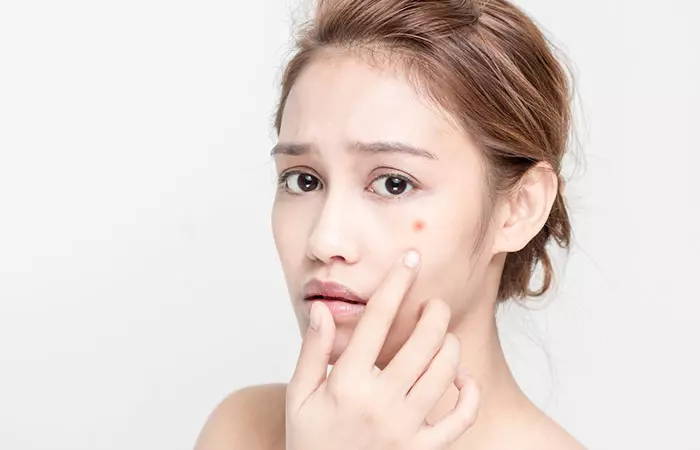
And the fiber stabilizes blood sugar levels. Imbalanced blood sugar levels can stress your hormones, causing breakouts or pimples. Gram flour can prevent that.
You can create a brilliant face pack with gram flour for acne. Combine equal parts of gram flour and turmeric. To this, add a teaspoon each of lemon juice and raw honey. Mix in a bowl. Apply this mask to your damp and makeup-free face and neck and leave it on for 10 minutes. Rinse with warm water. Your skin might have a slight orange tint until your next wash.
2. Removes Tan
Wondering how to use besan for tan removal? Well, mix 4 teaspoons of besan with 1 teaspoon of lemon juice and yogurt. Add a pinch of salt and mix to form a smooth paste. Apply the mask all over your face and neck and wait until it dries. Rinse with cool water. You can repeat this procedure daily before you take a bath.
3. Exfoliates Dead Skin
You can also use gram flour as a body scrub and exfoliate your dead skin.
All you have to do is mix 3 teaspoons of the flour with 1 teaspoon of ground oats and 2 teaspoons of corn flour. You can add a little raw milk too. Mix thoroughly. Apply this mask to your body and scrub.
The scrub works very well and removes dead skin cells all over your body.
Alessandra, a blogger, shared her experience of using a face mask made of gram flour, yogurt, and lemon to exfoliate her skin and was impressed by its results. She said, “ I tried for my daughter, and myself, and I am very happy with it. I have not been able to trust ready made exfoliants ever since (i).”
It also removes excess sebum and dirt. You can use this mask in your bath.
4. Reduces Oiliness
Mix equal parts of besan and yogurt or raw milk. Apply it to your face. Leave it on and wash your face after 20 minutes. This process cleanses your skin and reduces the oiliness.
5. Removes Fine Facial Hair
Using besan for facial hair removal is very effective.
Mix equal parts of besan and fenugreek powder. Prepare a paste. Apply the mask over your facial hair and wait for it to dry. Post this, you can wash it off.
6. Can Offer Instant Fairness
Heading to a party and missing that glow on your face? You can create homemade besan face packs to help you get radiant, healthy skin. Besan can offer instant fairness.
So, how to use gram flour for skin whitening? All you need to do is mix 4 teaspoons of gram flour with 1 teaspoon of orange peel (ground) and ½ teaspoon of malai. Apply the mask all over your face and neck. Leave it on for 15 minutes, post which you can rinse with cool water.
This remedy also works great for dark arms and neck. You can repeat the procedure thrice a week for better results.
There are other ways you can use gram flour for your skin –
- For Acne Scars – Mix besan, a pinch of turmeric powder and 2 table spoons of fresh milk to create a smooth paste and apply evenly on the face and neck area. After 20-25 minutes, wash off with lukewarm water to achieve glowing skin.
- For Dry, Flaky Skin – Mix 2-3 drops of fresh lemon juice with 1 tablespoon besan, 1 teaspoon milk cream or olive oil and ½ teaspoon honey to form a paste. Apply it all over the face and rinse it thoroughly with water when it dries naturally.
- For Oily Skin – Beat one egg white and add 2 tablespoons of besan to make it into a mask. Apply this mask for 15 minutes and wash it off with cold water.
- For Blemish-free Skin – You just need 50 grams of lentils, 10 grams of fenugreek seeds, and 2-3 pieces of turmeric. Grind all the ingredients into a powder and store it in a container. Use this powder in a little quantity with some milk cream and wash the face regularly with it instead of soap.
What Are The Benefits Of Gram Flour For Health
Gram flour, or chickpea flour is a highly nutritious food which provides us with lots of health benefits. Learn here what they are in detail.
7. Helps Lower Cholesterol
According to a report by the University of Toronto, one serving of chickpeas a day can reduce bad cholesterol ( 2). And the flour, as we saw, is rich in fiber (both soluble and insoluble) that can contribute to cholesterol reduction. In one Australian study, a diet containing gram flour lowered more bad cholesterol than a diet that contained wheat (3).
According to a report by the Centers for Disease Control and Prevention (CDC), 10% of US adults aged 20 or above had above 240 mg/dL cholesterol levels between 2017 to 2025. The report also states that about 17% have good cholesterol or high-density lipoprotein cholesterol levels below 40 mg/dL.
Another Australian study states the gram flour is rich in fiber and polyunsaturated fatty acidsi Healthy dietary fats that include omega-3 and omega-6 fatty acids and are good for heart health. . These could also help them to lower cholesterol levels (4). And a Chinese study links the consumption of gram flour to beneficial effects on serum cholesterol levels (5).
8. Controls Diabetes
Studies suggest that consuming legumes alone (chickpeas, especially) can improve the health of diabetics. Simply including them in your diet prevents diabetes as well as other associated diseases like heart ailments. More importantly, legumes are recognized as having a low glycemic index(6).
And according to the American Diabetes Association, gram flour can be a diabetic superfood. Harvard Medical School reports that chickpeas have a GI value of 10, which is a significantly low number. And by the way, always opt for dried chickpeas and not canned ones. Because canned chickpeas are preserved in brine (water saturated with salt), and this can increase its GI to 38.
And since gram flour contains fiber, we have another advantage – fiber slows down the absorption of blood sugar and can reduce the risk of type 2 diabetes. And this very fiber also keeps your appetite in control – helping prevent diabetes-related obesity.
As per another study published in the American Journal of Clinical Nutrition, consuming gram flour can lower postprandial (the period after lunch or dinner) blood glucose levels at 30 minutes and 60 minutes after eating. It also lowers insulin levels in the blood 120 minutes after consumption (7).
According to a report by the North Dakota State University, a diet rich in legumes could be a natural and cost-effective solution to prevent and even treat type 2 diabetes (8). And, without side effects.
9. Helps Improve Heart Health

Given that gram flour is rich in vitamins, minerals, and fiber, including it in your diet can promote heart health. Legumes have been found to lower the risk of heart disease. Three tablespoons of gram flour can give you the same amount of potassium as a banana (9). And potassium is known to lower blood pressure – thereby protecting the heart as well.
You can consume several servings of chickpeas in a week as they are nutrient-dense – they contain a lot of nutrients in relation to their calories.
Gram flour also contains compounds called saponins, which can lower blood cholesterol levels (10).
10. Can Aid Weight Loss
A 2010 study reveals the efficacy of gram flour in inducing weight loss. The study, conducted on 42 participants for 12 weeks, showed that the satiation levels post gram flour consumption had increased.
This ability of gram flour to aid weight loss can be attributed to their fiber and protein – two nutrients that can help you lose pounds.
Another study published in the 2011 issue of Nutrition Journal stated that a high-protein diet could be more effective than a high-carb diet when it comes to weight loss (11). You can use gram flour instead of meat to boost your fiber intake – doing this also helps reduce your intake of saturated fats, which are harmful. You can even add gram flour to make pancakes.
Protein is also found to have a high thermic effecti The measurement of energy expended on digestion of food, along with absorption and storing of nutrients. – meaning your body burns calories just by breaking down protein into amino acids. Protein’s thermic effect is about 30%, which simply means that you will burn 30% of your calories during digestion.
If you are consuming the beans instead of the flour, keep in mind the portion control. As a cup of the cooked peas contains about 270 calories.
Gram flour can not only induce weight loss but also prevent the weight from coming back (12).
11. Healthy Alternative To Gluten
Gram flour is naturally gluten-free, and that’s a boon if you are allergic to gluten. And as it has a subtle flavor, it can be a great addition to almost any savory dishes or desserts. In fact, it is so healthy that the flour is used as a staple outside India too – especially in countries of the Middle East.
Another reason this flour works great for preparing baking goods is its binding property – it absorbs liquids pretty quickly, and its binding property gives great structure to baked items. And since it’s a heavy flour, you can use it in the place of eggs as well (good news for vegans). So, yes, if you are gluten intolerant – no problem! You still can have baked foods. Even baking and cooking foods from scratch can be one easy way to avoid gluten in your diet.
Also, we have a tip here – gram flour slightly tastes like beans. Hence, if you are using more than one-fourth cup in a recipe, you can add a little more sweetener to mask its taste.
12. Can Help Treat Anemia
We know anemia is the result of iron deficiency. And this is where gram flour comes to the rescue. Gram flour contains good amounts of iron. Scale this to the number of cups of the flour you are adding to your recipe, and you will know how much of iron you are getting.
The iron from gram flour can be especially helpful for those who only prefer a vegetarian diet and who cannot get their daily dose of iron from meat. Apart from preventing anemia, iron also plays a role in the production of red blood cells and helps them carry blood to all the cells in your body. The mineral also enhances metabolism and aids in energy production.
13. Prevents Colorectal Cancer
According to a Mexican study, gram flour can offer protection against colon cancer. Gram flour achieves this by decreasing the oxidation of DNA and proteins and inhibiting the functioning of beta-catenin, an important oncogenic (causing tumors) protein in colon cancer (13).
Gram flour also contains saponins and lignans that help prevent colon cancer (14). They also contain resistant starch that protects the colon cells – resistant starch is the starch that goes undigested in the small intestine, and is hence used by the healthy colon bacteria to protect the colon.
Gram flour also contains antioxidants like flavonoids, triterpenoids, protease inhibitors, sterols, and inositol. And as per a Turkish study, incorporating legumes into your diet can have several beneficial physiological effects, one of them being the prevention of colon cancer (15).
Studies have also shown that countries with a higher consumption of legumes had fewer incidences of colorectal cancer. Legume seeds could also be an alternative therapy against various cancers (including that of the colon). Another Mexican study had successfully proven the anticancer activity of legumes in the early stages of the disease (16).
A recent Portuguese study states that consumption of gram flour can inhibit MMP-9 gelatinase protein, which is responsible for the progression of colorectal cancer in humans (17). Higher intake of legumes may reduce the risk of colorectal adenoma, which is a type of tumor formed in the colon tissue (18). However, further studies are warranted in this regard. .
The required daily amount of fiber is 25 grams, and gram flour, being rich in fiber, can help us meet this requirement. Fiber, as we have seen, reduces the risk of colon cancer (19). Legumes like chickpeas were also found to improve the functioning of blood vessels.
The fiber in gram flour aids digestion and regulates your bowel movements. It also helps treat constipation (20). If you want to consume fiber in a snack form, simply roast chickpeas with maple syrup in the oven for about 20 minutes .
 Trivia
Trivia14. Prevents Fatigue
The fiber in gram flour can also help prevent fatigue. How this happens is quite interesting. Fiber slows down digestion, and this makes sugar move much slowly from your digestive tract to the bloodstream. This means you are less likely to develop a sugar spike after eating. And this means you will not experience fatigue following a subsequent sugar crash.
A cup of cooked chickpeas contains about 12.5 grams of fiber, which is half of the recommended daily intake.
15. Regulates Blood Pressure
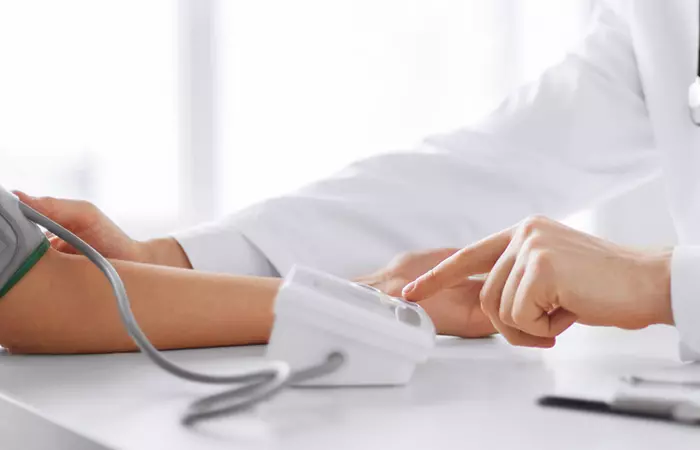
One good thing about gram flour is it is naturally low in sodium. And when you use gram flour in your diet, it can definitely prevent high blood pressure. As per reports, a healthy adult must not have more than 2,300 milligrams of sodium in a day.
Legumes, in general, are rich in fiber, magnesium, and potassium; these nutrients have been found to help lower blood pressure levels (21). They can also reverse the changes that occur in the blood vessels due to high blood pressure.
Gram flour was also found to improve the blood flow to the legs in individuals suffering from peripheral artery diseasei A disease caused by a build-up of deposits of calcium or fatty acid in the walls of arteries obstructing the blood flow. (a disease closely linked to coronary heart disease). They could also offer a non-pharmacological way of treating ailments linked to blood vessel dysfunction.
According to a Canadian study, diets including gram flour can attenuate hypertension and improve the health of blood vessels (22). And another Swedish study stated that a diet rich in legumes could regulate blood pressure and reduce the related cardiometabolic riski Risk of heart and metabolic diseases such as diabetes, stroke, cardiac arrest, or hypertension. in healthy individuals ( 23). More studies encourage the intake of legumes to achieve optimal blood pressure levels (24).
16. Strengthens Bones
As per a report published by the Physicians Committee for Responsible Medicine, gram flour contains a lot of calcium. In addition to that, it also contains magnesium, a mineral the body uses along with calcium to build strong bones (25).
Other ways you can strengthen your bones is by regularly exercising and consuming adequate amounts of vitamin D (the vitamin controls your body’s use of calcium). And it is as important to reduce calcium loss too – this can be achieved by limiting salt consumption, getting your protein preferably from plant sources, and giving up smoking and alcohol.
17. Enhances Brain Health
We already saw that gram flour contains magnesium. These legumes, and the flour made from them (obviously), stock your body with the mineral. Magnesium makes your brain cell receptors happy. It also relaxes the blood vessels, thereby allowing more blood flow to the brain (26).
Gram flour contains B vitamins and other phytonutrientsi Chemical compounds derived from plants that have antioxidant properties and protect healthy cells from damage. that boost your brain health (27). They also keep the blood sugar levels stable by providing an even supply of glucose – and glucose, guess what, is the perfect brain fuel.
18. Lowers Inflammation
As per a Pakistani study, besan (another name for gram flour) has anti-inflammatory properties and can hence lower inflammation (28). It also contains butyrate, a short-chain fatty acid, which lowers inflammation of the colon (29).
19. Fights Allergies
According to the National Institutes of Health, chickpeas are among the richest sources of vitamin B6, and this nutrient works great in supporting the immune system.
Besan also contain vitamin A that strengthens the immune system. The legumes contain zinc as well, another nutrient that bolsters the immune system (30).
How Does Gram Flour Benefit Your Hair?
Using besan for hair can give you great results. You can try a few of these homemade hair masks for healthy hair.
20. Cleanses Hair

Thinking, how to apply besan on hair? Add some besan to a bowl. Add some water and mix until you get a smooth paste. Apply the paste to your damp hair. Let it stay for 10 minutes. Then, rinse with water. You can follow this procedure once in 2 to 3 days.
21. Aids Hair Growth
The protein in besan can benefit your hair immensely. You can use the flour the same way as you used it to cleanse your hair.
For long hair, you can also mix gram flour with almond powder, curd, and a teaspoon of olive oil. In case you have dry and damaged hair, add 2 capsules of vitamin E oil. Apply to your hair and rinse it with cold water after it dries. Repeat twice a week.
22. Fights Dandruff
Mix 6 tablespoons of besan with the required amount of water. Massage this mask into your hair and leave it on for 10 minutes. Rinse with cold water.
23. Nourishes Dry Hair
You can take 2 tablespoons of besan and water as required. Mix with them 2 teaspoons of honey and 1 teaspoon of coconut oil. You can also add a few drops of essential oil if you want. Massage this shampoo to your damp hair while in the shower. Leave it on for a few minutes and then rinse with warm water.
That’s about the benefits of besan. But you also need to know how to buy and use it, right?
Gram Flour Nutrition Facts
Here you can view the nutrition for gram flour including calories, carbs, fat, protein, and more.
Gram flour (besan) Nutrition Facts & Calories Amounts per 1 cup (92g) | ||||
Calorie Information | ||||
Amounts Per Selected Serving | %DV | |||
Calories | 356(1491 kJ) | 18% | ||
| From Carbohydrate | 217 (909 kJ) | 18% | ||
| From Fat | 51.5 (216 kJ) | 9% | ||
| From Protein | 88.0 (368 kJ) | 41% | ||
From Alcohol | 0.0 (0.0 kJ) | |||
Vitamins | ||||
Amounts Per Selected Serving | %DV | |||
| Vitamin A | 37.7IU | 1% | ||
| Vitamin C | 0.0mg | 0% | ||
| Vitamin D | ~ | ~ | ||
| Vitamin E (Alpha Tocopherol) | 0.8mg | 4% | ||
| Vitamin K | 8.4mcg | 10% | ||
| Thiamin | 0.4mg | 30% | ||
| Riboflavin | 0.1mg | 6% | ||
| Niacin | 1.6mg | 8% | ||
| Vitamin B6 | 0.5mg | 23% | ||
| Folate | 402mcg | 101% | ||
| Vitamin B12 | 0.0mcg | 0% | ||
| Pantothenic Acid | 0.6mg | 6% | ||
| Choline | ~ | |||
| Betaine | ~ | |||
Minerals | ||||
Amounts Per Selected Serving | %DV | |||
| Calcium | 41.4mg | 4% | ||
| Iron | 4.5mg | 25% | ||
| Magnesium | 153mg | 38% | ||
| Phosphorus | 293mg | 29% | ||
| Potassium | 778mg | 22% | ||
| Sodium | 58.9mg | 2% | ||
| Zinc | 2.6mg | 17% | ||
| Copper | 0.8mg | 42% | ||
| Manganese | 1.5mg | 7.4% | ||
| Selenium | 7.6mcg | 11% | ||
| Fluoride | ~ | |||
| *Percentage daily value are based on a 2000 calorie diet. Your daily values may be higher or lower depending on your calorie needs | ||||
|---|---|---|---|---|
| Source: Nutrient data for this listing was provided by USDA SR-21. | ||||
Source: USDA, chickpea flour
How To Buy And Use Gram Flour?
Gram flour is a healthier substitute for wheat flour for people who are gluten intolerant because it is gluten-free and has higher protein and fiber content (31).
How To Buy And Use Gram Flour
You can find gram flour (besan) in your nearest grocery store, often grouped together with other gluten-free flours.
And you can use the flour in a number of ways:
- You can use the flour to prepare breads and other baked goods. You also can mix it with some wheat flour or use it all by itself for a gluten-free recipe.
- If you want to add a little extra crunch to your grilled steaks or pork chops, you can press with a little gram flour (after brushing with oil).
- If you want to thicken your soup, gram flour would be a great idea. Stir a little finely ground gram flour in the soup. It absorbs the liquids without clumping and adds a buttery flavor to the soup.
- The flour works fantastically well on vegetable fritters. It makes a great coating for deep-fried vegetable fritters. All you have to do is whisk it with some salt and enough water to make a thin batter. Dip in your veggies into this batter and fry until they turn golden.
Storage Tips:
Store gram flour in an airtight container in a cold, dry location to preserve freshness. Consider freezing or refrigerating the flour for an extended shelf life. Before using, always make sure there is no rancid smell or discoloration.
Any Gram Flour/Chickpeas Flour Recipes?
Yes – we have two popular gram flour recipes below.
1. Italian Chickpea Flour Bread
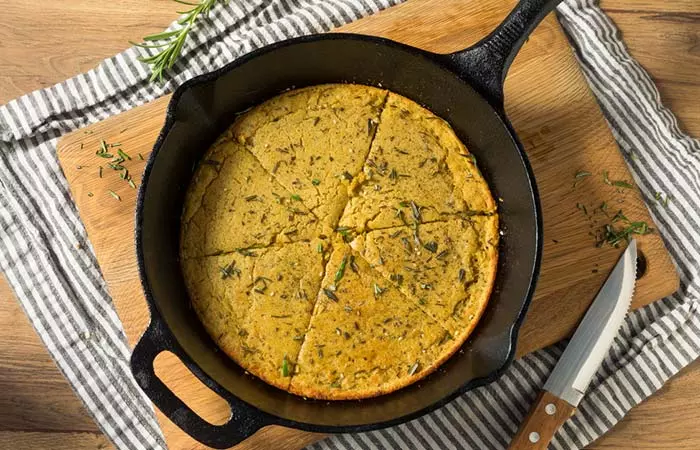
What You Need
- 1 cup of gram flour
- 1 cup of water
- 2 tablespoons of oil
- Cooking spray
- 1 ½ teaspoons of Italian seasoning
- 1 ½ teaspoons of rosemary, chopped and dried
- Ground black pepper, to taste
- A pinch of salt, if required
Directions
- Whisk the flour and water in a bowl until the mixture is smooth. Let it sit at room temperature for 2 to 6 hours.
- Preheat the oven to 450o F. Use the cooking spray on the inside of a metal pie pan.
- Skim the foam from the top of the gram flour-water mixture. Now, add the oil, Italian seasoning, and rosemary – and stir until combined.
- Pour this mixture into the metal pie pan and sprinkle black pepper and salt over the top.
- Bake in the preheated oven until the edges turn brown. It should take about 15 minutes. Remove the bread from the pan and cut it into wedges.
2. Chickpea Flour Choco Chip Cookies
What You Need
- ½ a cup of melted coconut oil
- ¼ cup of natural honey
- 1 egg
- 1 teaspoon of vanilla extract
- 1 and ½ cup of chickpea flour
- ¾ teaspoon of baking soda
- ½ a teaspoon of salt
- ¾ cup of Ghirardelli 60% cocoa chocolate chips
- ¼ cup of chopped nuts and brown sugar
Directions
- Preheat oven to 350 degrees F.
- Line a large sheet with parchment paper. In a bowl, mix together the chickpea flour and baking soda and salt.
- In another bowl mix all the other ingredients except for the chocolate chips and nuts. Ensure the coconut oil and honey are warm.
- Fold in the chocolate chips and nuts.
- Spoon onto a baking sheet and sprinkle a little brown sugar.
- Bake for about 12 minutes. Cool after baking.
3. Chickpea Flour Omelet
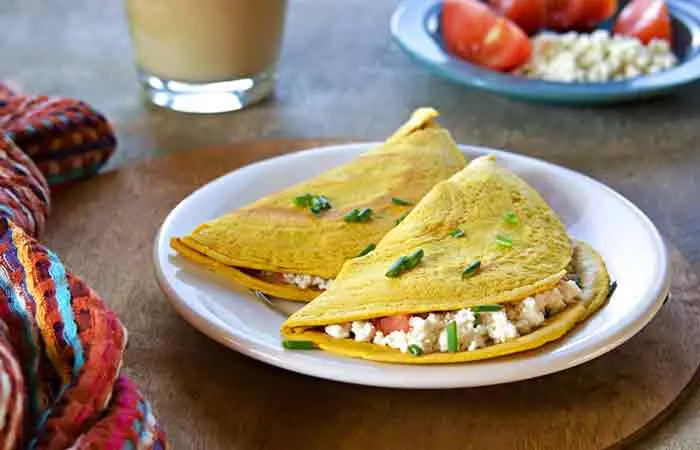
What You Need
- ⅓ cup of chickpea flour
- ⅓ cup of cold water
- A pinch of black salt
- 2 teaspoons of olive oil
- 1 tablespoon of vegan cheese, shredded
- 2 diced bell peppers
- 2 chopped onions
- A cup of sautéed mushrooms
- 1 tablespoon of freshly chopped chives
Directions
- Heat the olive oil in a pan for a few minutes.
- Combine the chickpea flour, water, and black salt in a bowl and whisk thoroughly.
- Pour the mixture into the hot pan.
- Cook for 2 to 3 minutes until solid.
- Add cheese, peppers, onions, and mushrooms.
- Cook for 1 to 2 minutes until the edges are golden and crispy.
- Fold the omelet in half and slide it onto a plate.
- Garnish with chives before serving.
4. Gram Flour Pancakes
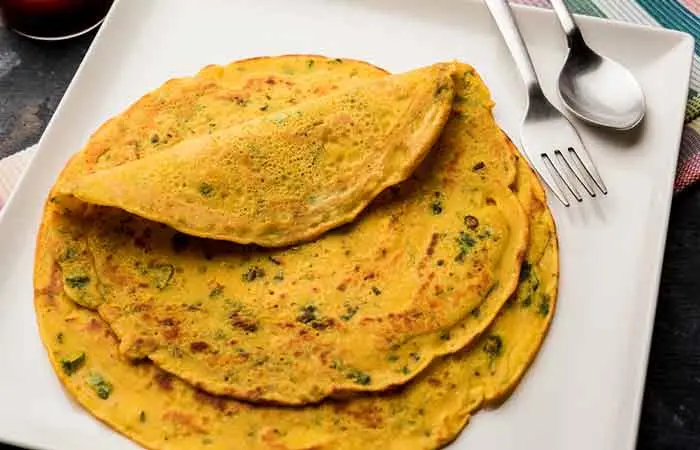
What You Need
- 1 cup of gram flour
- 1 cup of water
- 1 tablespoon of olive oil
- Pinch of salt
Directions
- Mix all ingredients to form a batter.
- Heat a non-stick pan, and pour in a ladle of batter.
- Cook until bubbles form, then flip and cook until golden brown.
- Serve with yogurt or chutney.
Well, that’s the super good part about gram flour. But this flour does have mild side effects.
What Are The Side Effects Of Gram Flour?
Even though the benefits of gram flour and uses are well known, its side effects can’t be overlooked. Read on to know what they are.
Digestive Issues
Certain people might experience stomach cramps and intestinal gas after consuming chickpeas or the flour. If taken in excess, you might also experience diarrhea and abdominal pain (32).
Legume Allergy
If you are sensitive to legumes, avoid gram flour (33).
Other Considerations
Excessive consumption of besan can also cause diarrhea (32).
That was all about besan side effects. We are sure you have a few more questions. But we have them covered!
Infographic: 6 Amazing Benefits Of Gram Flour
Gram flour is extremely versatile. This gluten-free flour is rich in fiber, carbohydrates, and protein and makes for a healthy diet. You can also use gram flour to maintain your hair and skin health. Scroll down to the infographic below and check out how besan can support your skin, hair, and overall health.
Some thing wrong with infographic shortcode. please verify shortcode syntax
Gram flour benefits skin, hair, and health in multiple ways. It is loaded with fiber and protein. It helps manage acne, removes tan, exfoliates dead skin, reduces oiliness, and helps in removing facial hair. In addition, gram flour also helps lower cholesterol levels, manages diabetes, and promotes brain, bone, and heart health. It also manages dandruff, promotes hair growth, and nourishes dry hair. However, some people may experience digestive issues, diarrhea, and legume allergy with gram flour. Hence, practice caution.
Frequently Asked Questions
How to make chickpea flour?
It is pretty simple! Place the dried chickpeas into your high speed blender. Pulse several times until the chickpeas are broken down into a fine powder. If you feel it is still coarse, pulse until a flour begins to form. Finally sift and store in a container.
Is eating gram flour good for piles?
Yes. Gram flour contains protein and numerous micronutrients like fiber, iron, and B-vitamins. Fiber, especially, makes the stool smoother. This offers relief.
Are garbanzo beans same as chickpeas?
They are the same.
Is there a substitute for gram flour?
Well, no.
It is readily available. It is economical. And it works wonders for your health. What more do you want!
Tell us how this post on benefits of gram flour has helped you. Just comment in the box below.
Does gram flour whiten your skin?
The powerful cleansing properties of gram flour (besan) can help remove a tan (33). However, it cannot lighten your natural skin tone.
Can we eat besan at night?
Yes. You can safely eat besan at night. It does not cause any adverse effects.
Gram flour, or besan, is a powerhouse of nutrition. Click on this video to learn about its amazing health benefits and how to use it in your meals.
Personal Experience: Source
StyleCraze's articles are interwoven with authentic personal narratives that provide depth and resonance to our content. Below are the sources of the personal accounts referenced in this article.
i. In praise of chickpea flour, eating broccolini flowers and carrot leaves, and natural skin carehttps://alessandrazecchini.blogspot.com/2011/07/in-praise-of-chickpea-flour-eating.html
References
Articles on StyleCraze are backed by verified information from peer-reviewed and academic research papers, reputed organizations, research institutions, and medical associations to ensure accuracy and relevance. Read our editorial policy to learn more.
- Nutritional quality and health benefits of chickpea (Cicer arietinum L.): a review, The British Journal of Nutrition, US National Library of Medicine, National Institutes of Health.
https://pubmed.ncbi.nlm.nih.gov/22916806/ - Effect of dietary pulse intake on established therapeutic lipid targets for cardiovascular risk reduction: a systematic review and meta-analysis of randomized controlled trials, Canadian Medical Association Journal.
https://www.ncbi.nlm.nih.gov/pmc/articles/PMC4016088/ - Dietary supplementation with chickpeas for at least 5 weeks results in small but significant reductions in serum total and low-density lipoprotein cholesterols in adult women and men, Annals and Nutrition and Metabolism, US National Library of Medicine, National Institutes of Health.
https://pubmed.ncbi.nlm.nih.gov/17191025/ - Chickpeas may influence fatty acid and fiber intake in an ad libitum diet, leading to small improvements in serum lipid profile and glycemic control, Journal of the American Dietetic Association, US National Library of Medicine, National Institutes of Health.
https://pubmed.ncbi.nlm.nih.gov/18502235/ - Dietary chickpeas reverse visceral adiposity, dyslipidaemia and insulin resistance in rats induced by a chronic high-fat diet, The British Journal of Nutrition, US National Library of Medicine, National Institutes of Health.
https://pubmed.ncbi.nlm.nih.gov/17666145/ - Consumption of a Legume-Enriched, Low-Glycemic Index Diet Is Associated with Biomarkers of Insulin Resistance and Inflammation among Men at Risk for Colorectal Cancer, The Journal of Nutrition, US National Library of Medicine, National Institutes of Health.
https://www.ncbi.nlm.nih.gov/pmc/articles/PMC2793121/ - Effects of long-term consumption and single meals of chickpeas on plasma glucose, insulin, and triacylglycerol concentrations, The American Journal of Clinical Nutrition, US National Library of Medicine, National Institutes of Health.
https://academic.oup.com/ajcn/article/79/3/390/4690125 - Antidiabetic potential of commonly consumed legumes: a review, Critical reviews in food science and nutrition.
https://pubmed.ncbi.nlm.nih.gov/24261538/ - Bananas, overripe, raw, U.S. DEPARTMENT OF AGRICULTURE.
https://fdc.nal.usda.gov/fdc-app.html#/food-details/1105073/nutrients - Nutritional quality and health benefits of chickpea, British Journal of Nutrition.
- High-protein, low-fat diets are effective for weight loss and favorably alter biomarkers in healthy adults, The Journal of Nutrition, US National Library of Medicine, National Institutes of Health.
https://pubmed.ncbi.nlm.nih.gov/14988451/ - Dietary chickpeas reverse visceral adiposity, dyslipidaemia and insulin resistance in rats induced by a chronic high-fat diet
https://pubmed.ncbi.nlm.nih.gov/17666145/ - Cooked Chickpea Consumption Inhibits Colon Carcinogenesis in Mice Induced with Azoxymethane and Dextran Sulfate Sodium, Journal of the American College of Nutrition, US National Library of Medicine, National Institutes of Health.
https://pubmed.ncbi.nlm.nih.gov/28657468/ - Chemical study and medical application of saponins as anti-cancer agents
https://pubmed.ncbi.nlm.nih.gov/20550961/ - Effect of cooking methods on selected physicochemical and nutritional properties of barlotto bean, chickpea, faba bean, and white kidney bean, Journal of Food Science and Technology, US National Library of Medicine, National Institutes of Health.
https://www.ncbi.nlm.nih.gov/pmc/articles/PMC3550881/ - Nutrient and nonnutrient components of legumes, and its chemopreventive activity: a review, Nutrition and Cancer, US National Library of Medicine, National Institutes of Health.
https://pubmed.ncbi.nlm.nih.gov/25710272/ - Healthy dietary patterns decrease the risk of colorectal cancer in the Mecca Region Saudi Arabia: a case-control study BMC Public Health US National Library of Medicine National Institutes of Health.
https://www.ncbi.nlm.nih.gov/pmc/articles/PMC5492351/ - Legume Consumption and Colorectal Adenoma Risk: A Meta-Analysis of Observational Studies, PLoS One, US National Library of Medicine, National Institutes of Health.
https://www.ncbi.nlm.nih.gov/pmc/articles/PMC3691186/ - Dietary fiber intake and risk of colorectal cancer and incident and recurrent adenoma in the Prostate, Lung, Colorectal, and Ovarian Cancer Screening Trial, The American Journal of Clinical Nutrition, US National Library of Medicine, National Institutes of Health.
https://www.ncbi.nlm.nih.gov/pmc/articles/PMC4588743/ - Is Chickpea a Potential Substitute for Soybean? Phenolic Bioactives and Potential Health Benefits
https://www.ncbi.nlm.nih.gov/pmc/articles/PMC6600242/ - Legumes: Health Benefits and Culinary Approaches to Increase Intake, Clinical Diabetes, American Diabetes Association, US National Library of Medicine, National Institutes of Health.
https://www.ncbi.nlm.nih.gov/pmc/articles/PMC4608274/#s4title - Lentil-based diets attenuate hypertension and large-artery remodelling in spontaneously hypertensive rats, The British Journal of Nutrition, US National Library of Medicine, National Institutes of Health.
https://pubmed.ncbi.nlm.nih.gov/24063808/ - Combining functional features of whole-grain barley and legumes for dietary reduction of cardiometabolic risk: a randomised cross-over intervention in mature women, The British Journal of Nutrition, US National Library of Medicine, National Institutes of Health.
https://pubmed.ncbi.nlm.nih.gov/24063257/ - Effect of Dietary Pulses on Blood Pressure: A Systematic Review and Meta-analysis of Controlled Feeding Trials, American Journal of Hypertension, US National Library of Medicine, National Institutes of Health.
https://www.ncbi.nlm.nih.gov/pmc/articles/PMC5391775/ - The Effects of Calcium, Magnesium, Phosphorus, Fluoride, and Lead on Bone Tissue
https://www.ncbi.nlm.nih.gov/pmc/articles/PMC8066206/ - The Role of Magnesium in Neurological Disorders
https://www.ncbi.nlm.nih.gov/pmc/articles/PMC6024559/ - Vitamin B6, National Institutes of Health.
https://ods.od.nih.gov/factsheets/VitaminB6-HealthProfessional/ - Platelet aggregation and anti-inflammatory effects of garden pea Desi chickpea and Kabuli chickpea Acta polobiae pharmaceutica US National Library of Medicine National Institutes of Health.
https://pubmed.ncbi.nlm.nih.gov/22876614/ - Potential beneficial effects of butyrate in intestinal and extraintestinal diseases
https://www.ncbi.nlm.nih.gov/pmc/articles/PMC3070119/ - Zinc as a Gatekeeper of Immune Function
https://www.ncbi.nlm.nih.gov/pmc/articles/PMC5748737/ - Effect of Processed Chickpea Flour Incorporation on Sensory Properties of Mankoushe Zaatar
https://www.ncbi.nlm.nih.gov/pmc/articles/PMC6560399/ - Gastrointestinal Tolerance to Daily Canned Chickpea Intake
https://pubmed.ncbi.nlm.nih.gov/26067078/ - Chickpea: a major food allergen in the Indian subcontinent and its clinical and immunochemical correlation
https://pubmed.ncbi.nlm.nih.gov/11527247/ - In-House Preparation and Standardization of Herbal Face Pack, The Open Dermatology Journal, ResearchGate.
https://www.researchgate.net/publication/320900643_In-House_Preparation_and_Standardization_of_Herbal_Face_Pack
Read full bio of Madhu Sharma
Read full bio of Ravi Teja Tadimalla
Read full bio of Arshiya Syeda
Read full bio of Sindhu Koganti






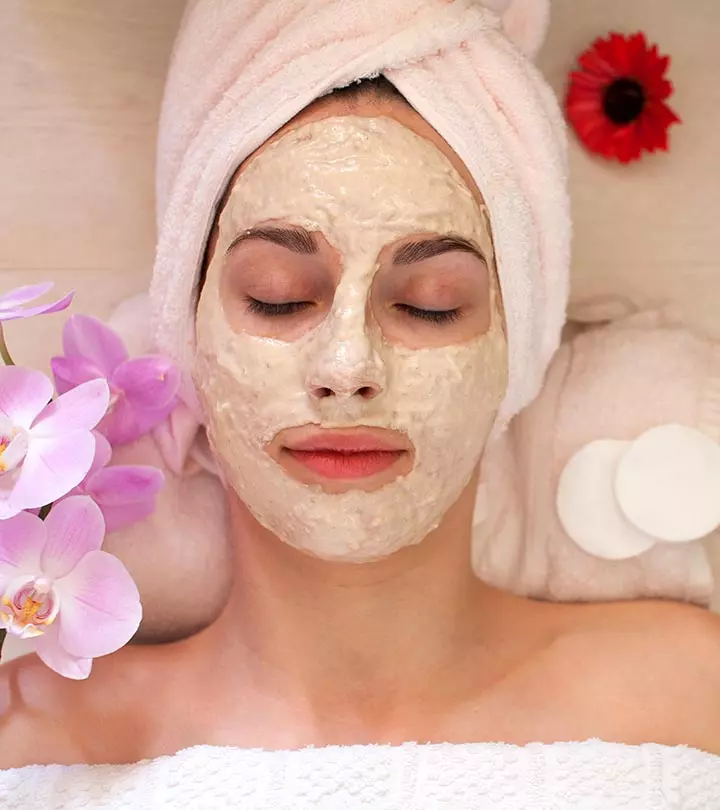
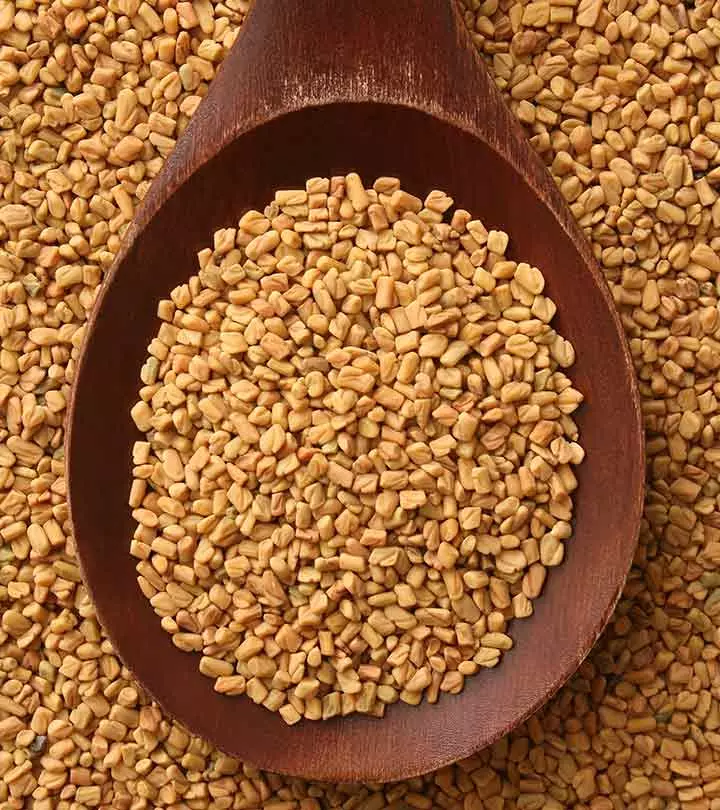
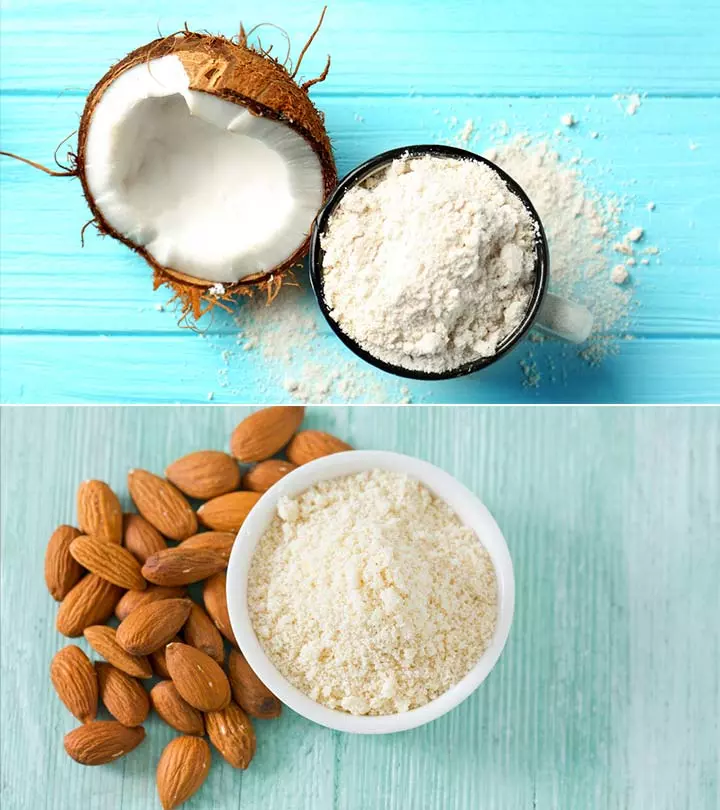
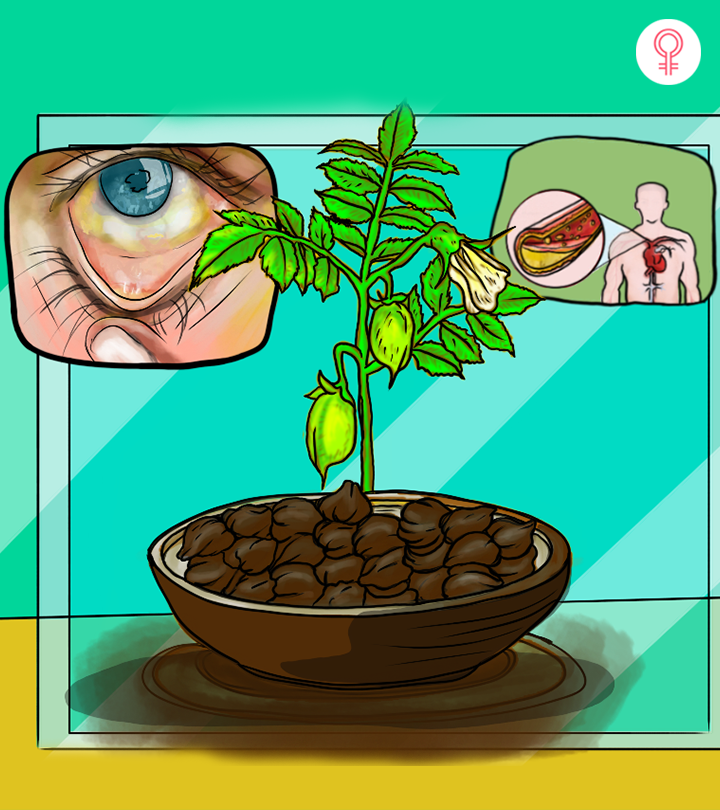
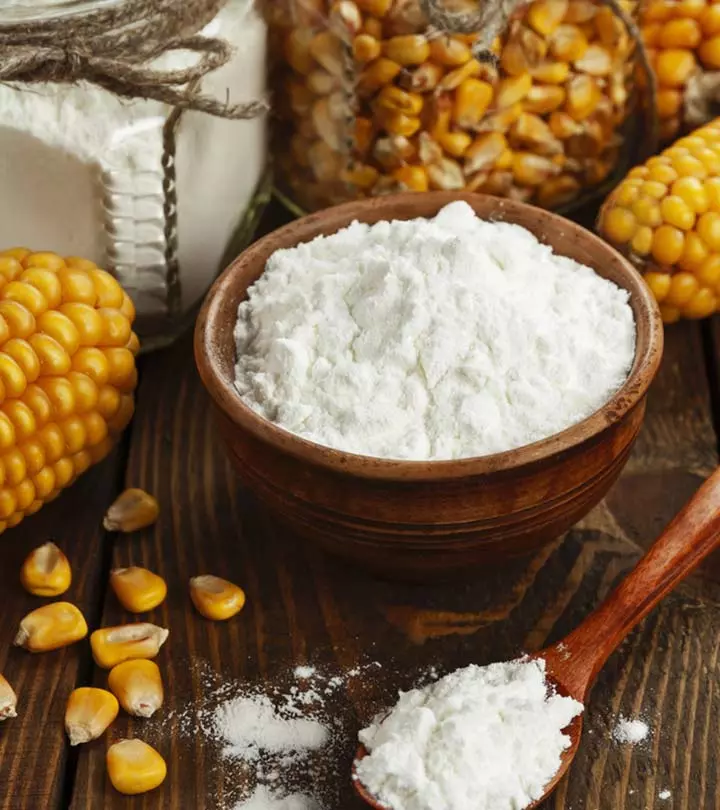
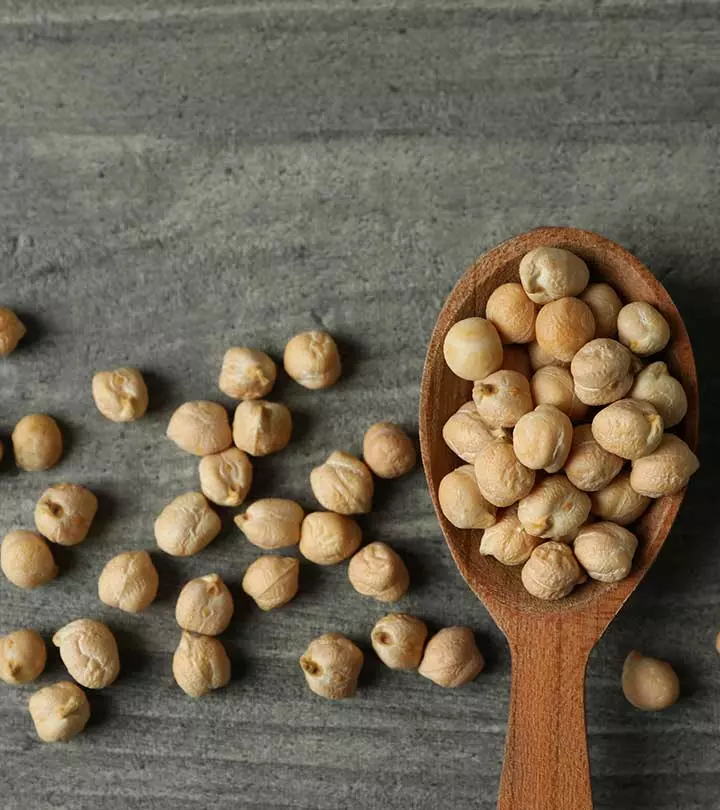
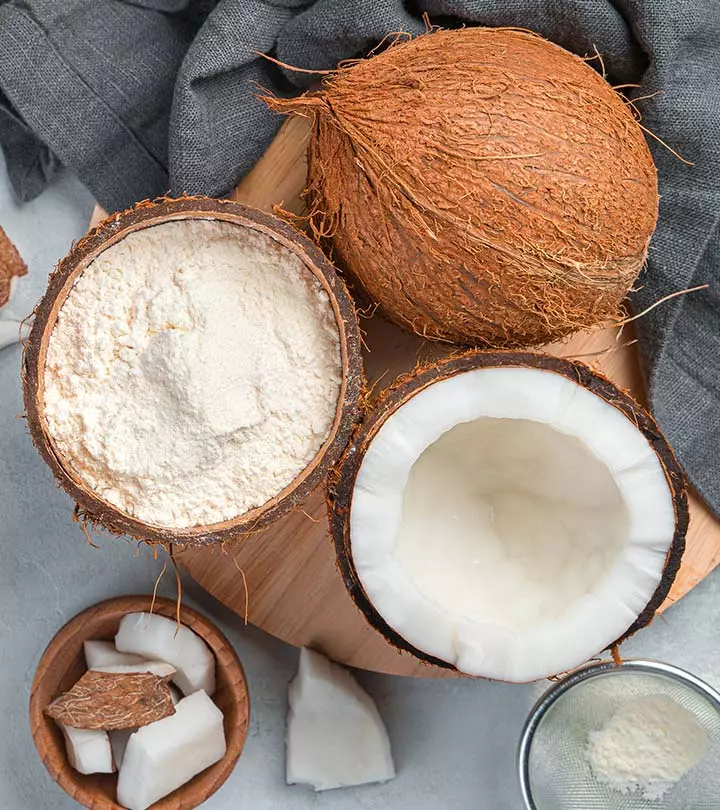
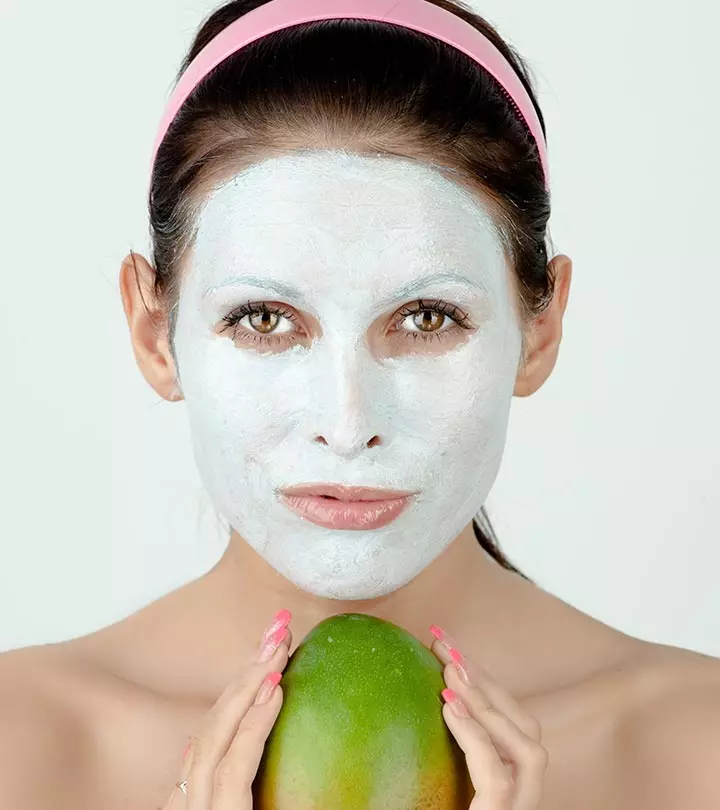

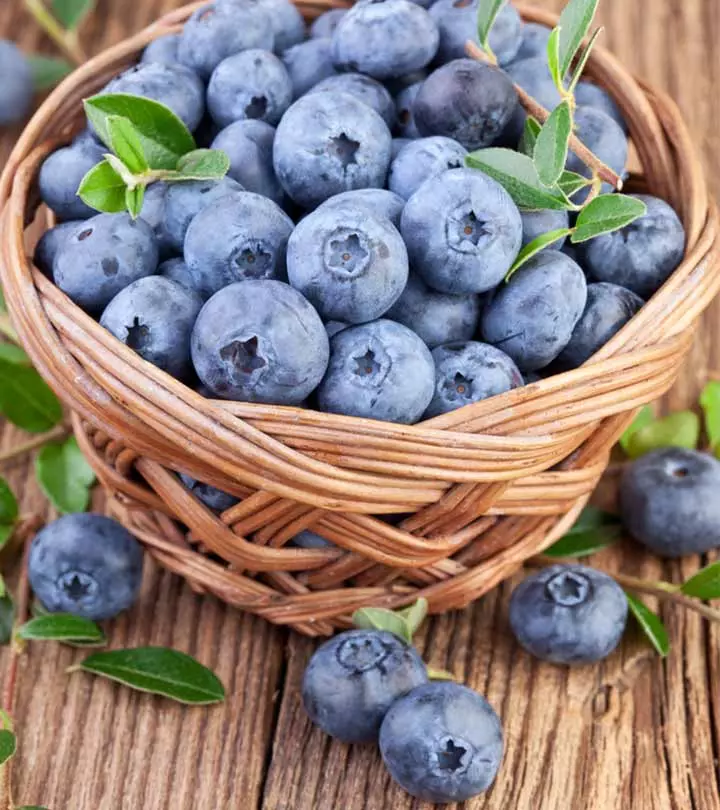

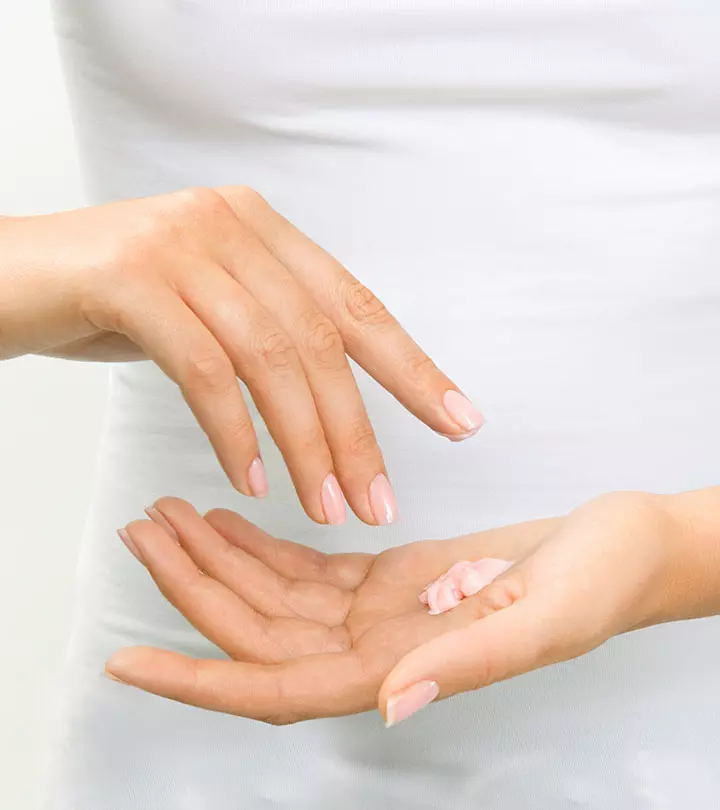

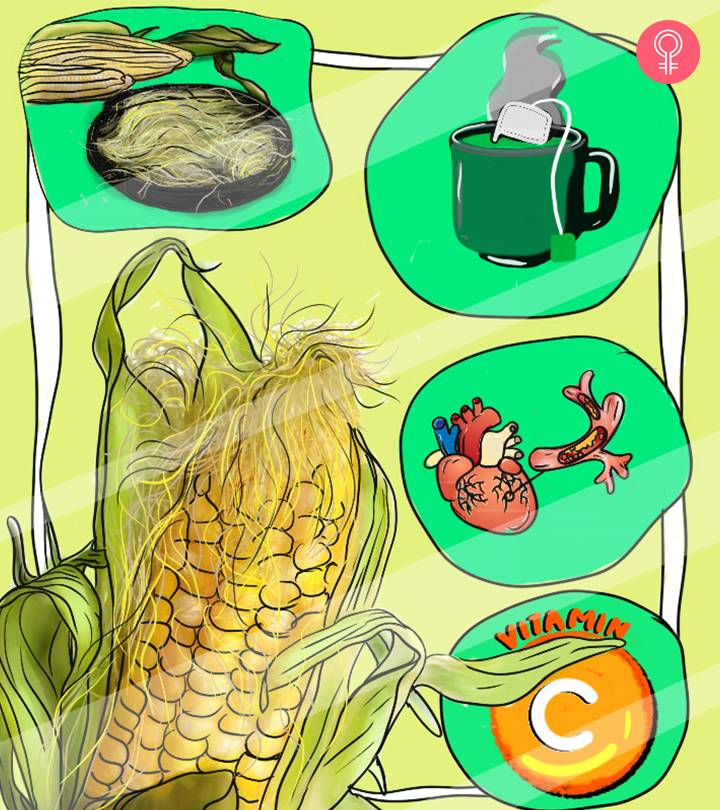
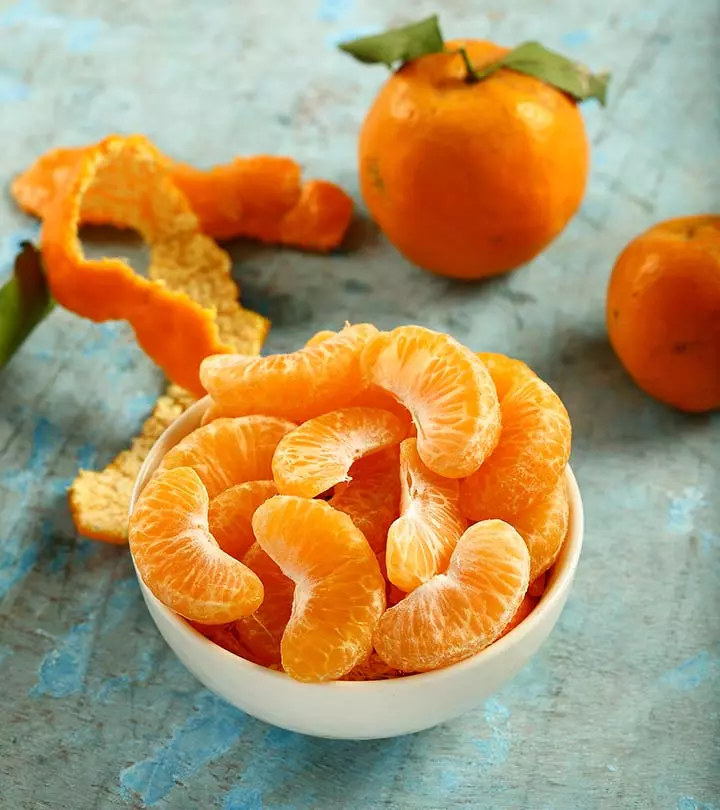
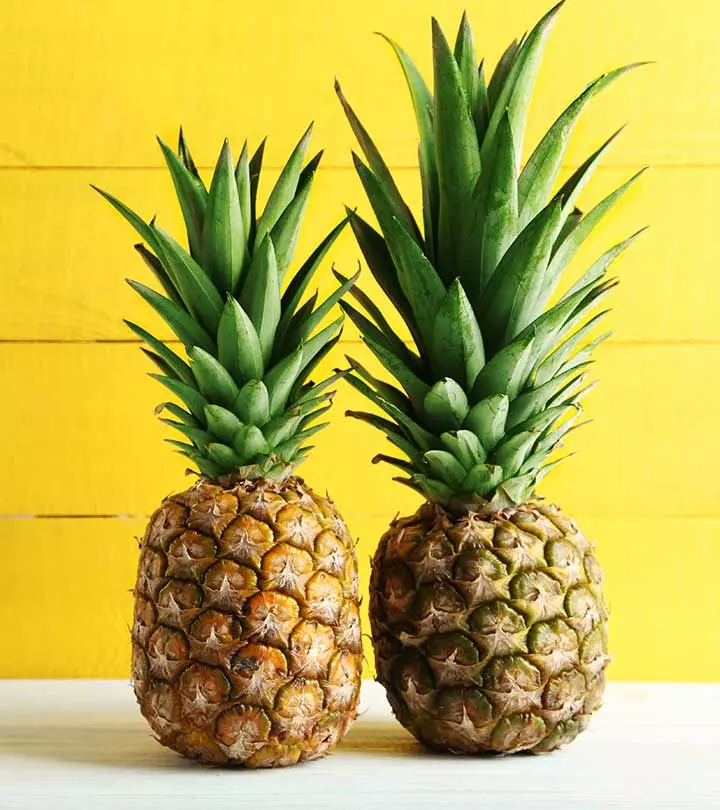
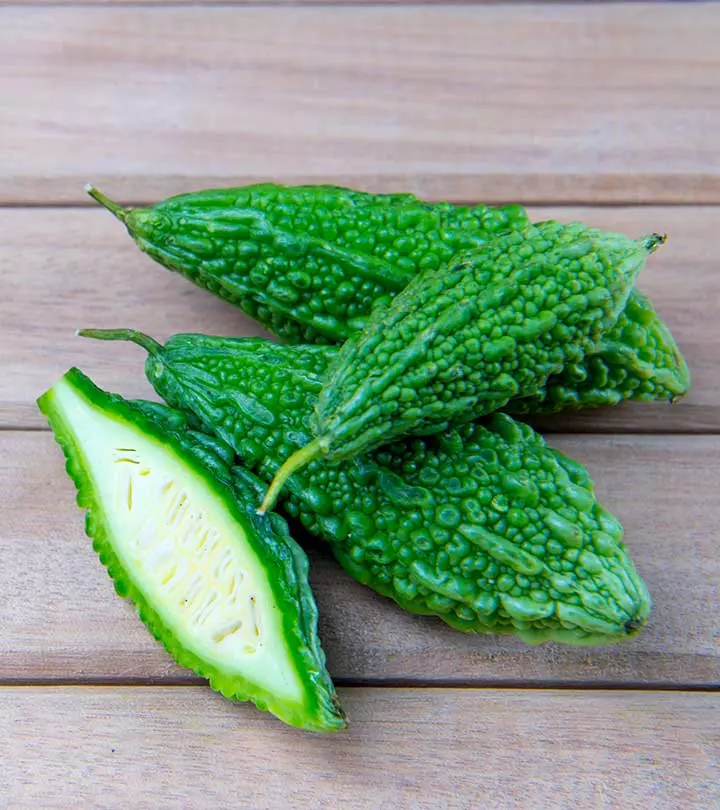
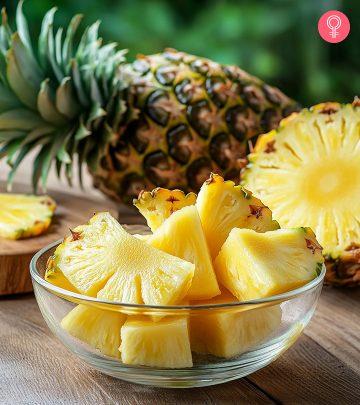
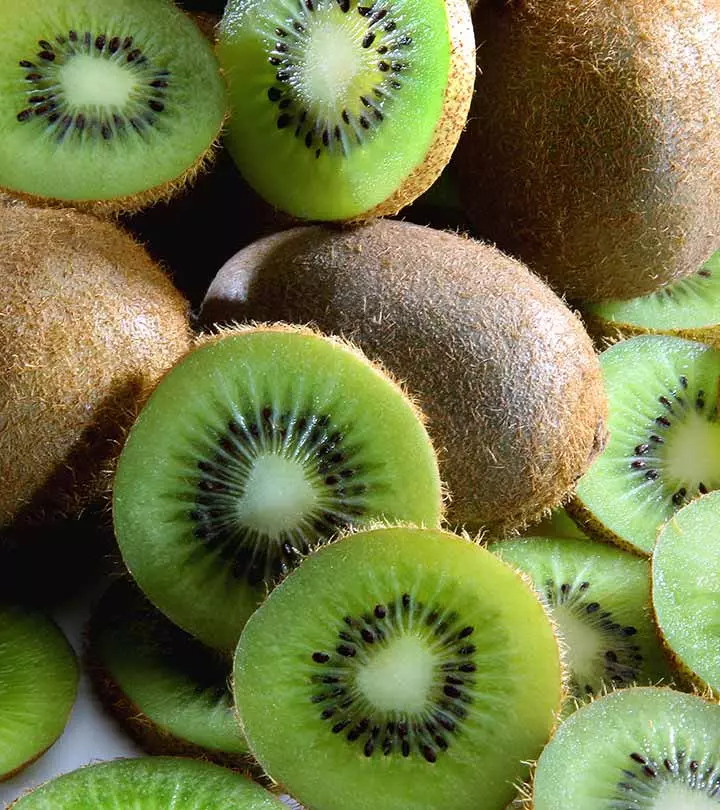
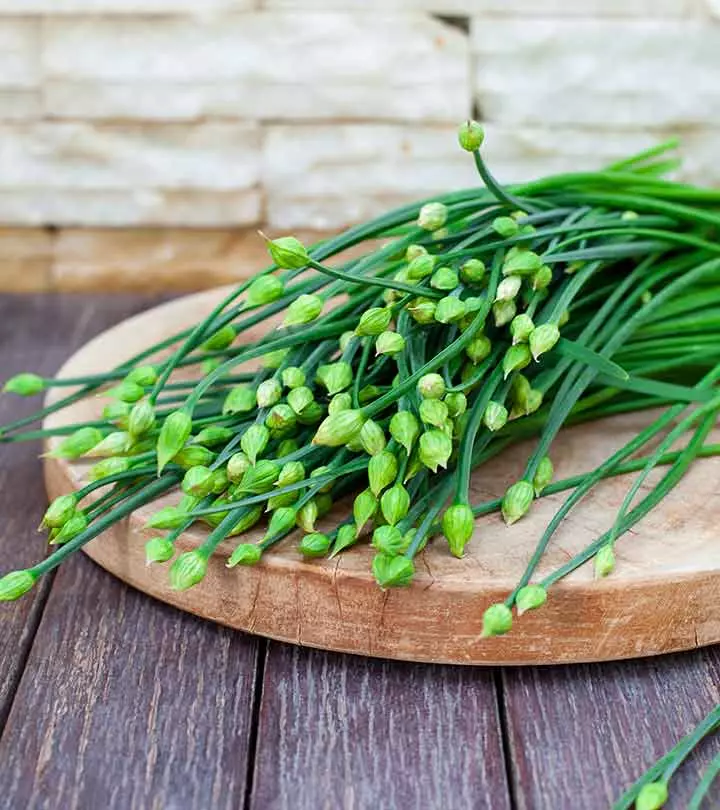
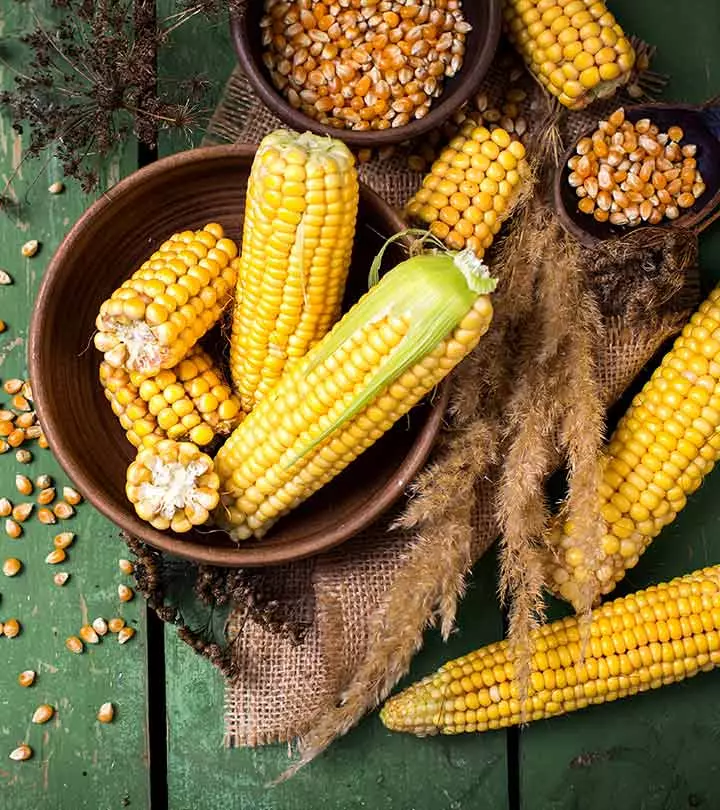
Community Experiences
Join the conversation and become a part of our empowering community! Share your stories, experiences, and insights to connect with other beauty, lifestyle, and health enthusiasts.